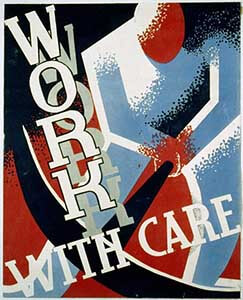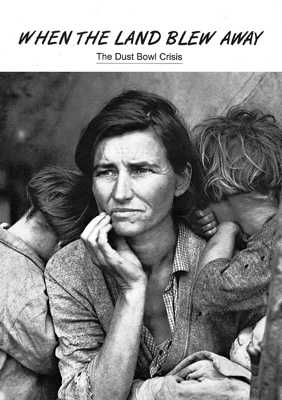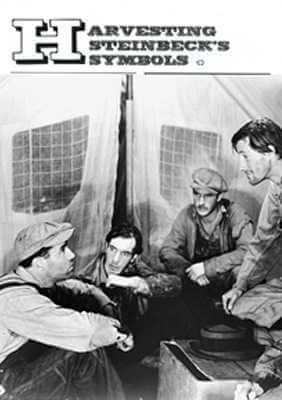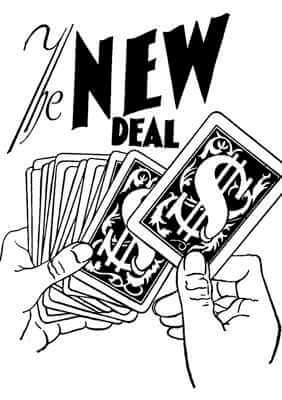The Grapes of Wrath & the American Dream
SERVING AMERICAN SECONDARY SCHOOLS FOR 28 YEARS
THE COLLEGE BOARD’S praise for The Grapes of Wrath & the American Dream:
“The exercises in this exhilarating volume focus on observation skills; theme, variation, and repetition in the novel; period music, and art. Its 11 chapters reveal the social production of art in action by showing the interpenetration of all the arts—painting, music, film, journalism, theater, and novels—to produce social change. A SURE-FIRE HIT WITH STUDENTS.“
TEMPO, Texas Association for the Gifted & Talented
“With an impressive group of contributors and consultants, Publisher/Editor Jesse Bryant Wilder has put together a stunning set of challenging materials that will provide outstanding learning experiences for secondary students.”
BLOOMFIELD HILLS HIGH SCHOOL, Bloomfield Hills, MI
“We’ve had very successful experiences with NEXUS. The presentation is accessible to advanced and to regular students. This year we look forward to using The Grapes of Wrath volume. It is just an excellent compilation of materials. I think these books are absolute treasures, just remarkable. For a single teacher especially, it pulls everything together. The magazine can take the place of a team of teachers.” – Susan Neun, English Chair
APPLETON EAST HIGH SCHOOL, Appleton, WI
“I haven’t seen any better material for connecting the curriculum, especially world literature and world history—and I have a lot of experience connecting the curriculum. In one instance, for example, my kids did their research topics on the artists and poets of the Harlem Renaissance and they created mini-documentaries on the artists or poets using the NEXUS materials. It went extremely well. You can see the editor has really done his research. His love of the material really shows.” – Michael W. Bergen, Communication Arts Chair
GENE MAEROFF, Founder of the Hechinger Institute on Education and Media, Teachers College, Columbia University
“NEXUS is a remarkable publication, one of the best of its kind for promoting interdisciplinary work by students. Each volume reflects careful research and is filled with information that both engages students and advances their understanding of how the disciplines complement each other.” – Gene Maeroff is the former Senior Fellow of the Carnegie Foundation for the Advancement of Teaching and former New York Times national education correspondent.”
BALDWIN-WOODVILLE HIGH SCHOOL, Baldwin, WI
“I am quite happy with the results I’ve received from my kids. Kids who are harder to engage enjoy the visuals and the real-world applications. Overall each volume provides research that any teacher would love to do, but doesn’t have the time to do, and the fact that NEXUS does it for us is very valuable.” – Marti Koller, English teacher
GREENHILLS SCHOOL, Ann Arbor, MI
“NEXUS magazines are wonderful! They are creative, scholarly and entertaining. The students love using them, and I just love the interdisciplinary approach. The magazines are also great for projects. I can send a group of students off to work from them. For example, we used HyperStudio and “Arab Astronomy” in The Lion in Winter and the Middle Ages” volume with the 9th grade.” – Orelia Dann, History teacher
(SEE TEXT SAMPLES BELOW IN GREEN.)
Writers and consultants in this volume include preeminent Steinbeck scholar Robert DeMott, editor of Working Days, The Journals of The Grapes of Wrath and author of Steinbeck’s Typewriter: Essays on His Art. DeMott also wrote the introduction to The Grapes of Wrath (Penguin Classics Series)and serves on the Steinbeck Review editorial board.
Susan Shillinglaw, former director of the Steinbeck Research Center at San Jose State Univ., co-author of A Journey into Steinbeck’s California, and editor of Steinbeck’s The Winter of Our Discontent.
Anne Loftis, author of Witnesses to the Struggle: Imaging the 1930s California Labor Movement.
Lorraine Brown, former director of the Research Center for Federal Theatre at George Mason Univ. and co-author of Free Adult, Uncensored, the Living History of the Federal Theatre Project.
Francis V. O’Connor, preeminent mural scholar, author of The WPA Era: Urban Views and Visions and editor of The New Deal Art Projects: An Anthology of Memoirs and Art for the Millions: Essays from the 1930’s by Artists and Administrators of the WPA Federal Art Project.
Marlene Park, co-author of New Deal for Art: The Government Art Projects of the 1930s and Democratic Vistas: Post Offices and Public Art in the New Deal, and former art history professor at CUNY.
Kenneth Bindas, author of All of this Music Belongs to the Nation: The WPA’s Federal Music Project and Modernity and the Great Depression. History Chair at Kent State Univ.
Paul Ferguson, writer for Jazz Player, Case Western Reserve Univ. Jazz Division Head, and former trombonist for the new Glenn Miller and Tommy Dorsey Orchestras.
Aligned with Common Core Standards. For secondary students.
CLICK IMAGE TO ENLARGE
The Grapes of Wrath Lessons Part I – Steinbeck Bio & the Backstory of The Grapes of Wrath
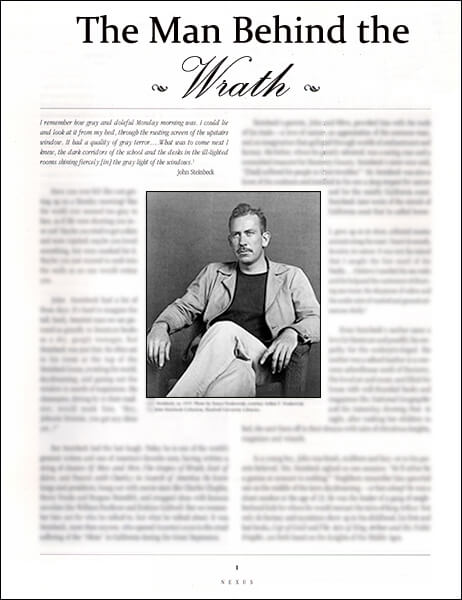
![]() Who is John Steinbeck and Why Did He Write The Grapes of Wrath? – 3 Pages & Activity
Who is John Steinbeck and Why Did He Write The Grapes of Wrath? – 3 Pages & Activity
The lesson “The Man Behind the Wrath” teaches students how Steinbeck evolved from awkward adolescent to Nobel Prize-winning activist author and examines the backstory and evolution of The Grapes of Wrath.
TEXT SAMPLE:
“Steinbeck observed the horrendous living conditions of the migrants…during the floods of 1937-38….He went to the flooded area to report on the tragedy, hoping his news articles would pressure local authorities to help. In a letter to his wife Carol, he said, ‘I want to put a tag of shame on the greedy [blankety-blanks] who are responsible for this, but I can best do it through newspapers.'”
This lesson satisfies Common Core Standard CCSS.ELA-LITERACY.RL.9-10.1
Cite strong and thorough textual evidence to support analysis of what the text says explicitly as well as inferences drawn from the text.
The Grapes of Wrath Lessons Part II – Steinbeck’s Themes and Symbolism 
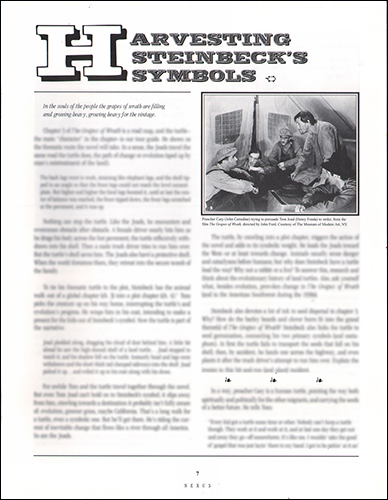
![]() Harvesting Steinbeck’s Symbols in The Grapes of Wrath – 3 Pages & Activities
Harvesting Steinbeck’s Symbols in The Grapes of Wrath – 3 Pages & Activities
In the NEXUS lesson “Harvesting Steinbeck’s Symbols,” students track the turtle and other migrating symbols in The Grapes of Wrath
TEXT SAMPLE:
Chapter 3 of The Grapes of Wrath is a road map, and the turtle – the main “character” in the chapter – is our tour guide. He shows us the thematic route the novel will take. In a sense, the Joads travel the same road the turtle does, the path of change or evolution (sped up by man’s mistreatment of the land).” [NEXUS, The Grapes of Wrath and the American Dream, p.7]
“The back legs went to work, straining like elephant legs, and the shell tipped to an angle so that the front legs could not reach the level cement plain. But higher and higher the hind legs boosted it, until at last the center of balance was reached, the front tipped down, the front legs scratched at the pavement, and it was up.”
“Nothing can stop the turtle. Like the Joads, he encounters and overcomes obstacle after obstacle. A female driver nearly hits him…” [NEXUS, The Grapes of Wrath and the American Dream, p.7]
This lesson also connects Casy and the turtle; both ride the crest of evolution in the novel. Like the turtle, Casy, the teacher and lapsed preacher, sows the seeds of the future on his spiritual journey through The Grapes of Wrath.
Figurative Language in The Grapes of Wrath.
The lesson includes activities and challenging questions that stimulate students to analyze pivotal passages in Steinbeck’s masterpiece, interpret his metaphors, and connect the politics in The Grapes of Wrath to analogous political situations today.
Lesson aligns with Common Core Standards CCSS.ELA-LITERACY.RL.1, RL.2, RL.4, RL.5, and RL.6 (for 9-10 and 11-12) as well as Anchor standards CCRA.R.1, R.2, R.3, R.4, R.5, and R.8.
The Grapes of Wrath Lessons Part III – Learning the Art of Seeing from Steinbeck:

![]() Lessons on Observation in The Grapes of Wrath and Life – 3 Pages & Activities
Lessons on Observation in The Grapes of Wrath and Life – 3 Pages & Activities
The lesson “Steinbeck in Focus – The Art of Seeing ” teaches students to exercise their observation skills while helping them to read The Grapes of Wrath more closely and deeply, to recognize and appreciate character sketches (based on Steinbeck’s observations and insights into human nature) and to make logical inferences from the text.
The concepts in this chapter are expanded upon in the NEXUS Supplement “Character Sketches à la Steinbeck,” which teaches students to write their own character. The exercises in the supplement:
- improve students’ observation skills by teaching them to observe and interpret body language, dialect, and gestures without judgment
- help students recognize the role body language plays in character sketches (aka word portraits)
- help students “read” character through habits of speech and manner of dress
- teach students to use descriptive rather than generic verbs to delineate character
TEXT SAMPLE:
“Are your observation skills 20/20? Actually our powers of observation are not usually tested directly, and most schools don’t offer courses that teach students how to see, how to observe. Good observers usually train themselves – like the truck driver in chapter 2 of The Grapes of Wrath.”
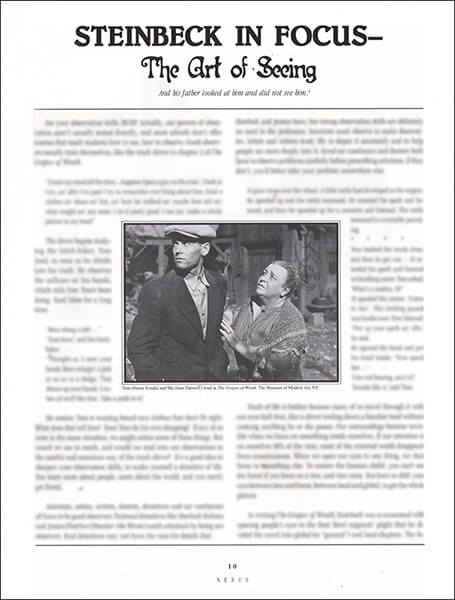
I train my mind all the time….Suppose I pass a guy on the road. I look at him, an’ after I’m past I try to remember ever thing about him, kind a clothes an’ shoes an’ hat, an’ how he walked an’ maybe how tall an’ what weight an’ any scars. I do it pretty good. I can jus’ make a whole picture in my head. [NEXUS, The Grapes of Wrath and the American Dream, p.10]
This lesson, its companion chapter “The Science of Seeing, ” and the NEXUS Supplement “Writing Character Sketches à la Steinbeck,” (aka “Character Sketches à la Steinbeck) include activities and exercises designed to sharpen students’ observation skills and help them to appreciate descriptive writing and include it in their own work:
- The “Literature” section of the NEXUS Grapes of Wrath Guidelines recommends observation activities in which students analyze “word portraits” (descriptions that rely on keen observation of natural phenomena) in The Grapes of Wrath and then write their own character sketches to exercise their observation skills and improve their descriptive writing.
- The NEXUS Supplement “(Writing) Characters Sketches à la Steinbeck” uses a passage from another Steinbeck work as a model to instruct students to closely observe telling actions that help define character and to teach them to use descriptive rather than generic verbs – verbs that convey not only action but the mood that prompts the action (trudged vs. walked, for example).
- See the chapter “The Science of Seeing” below, which examines Steinbeck’s work with marine biologist Ed Ricketts and teaches students methods for honing their observation skills in the field of science.
This lesson and the supplemental lesson align with Common Core Standards CCSS.ELA-LITERACY.RL.1, RL.3, RL.4, RL.5, and RL.6 (for 9-10 and 11-12), as well as Anchor standards CCRA.R.1, R.4, R.6, and R.8.
The Grapes of Wrath Lessons Part IV –
The Dust Bowl Crisis and the Novel
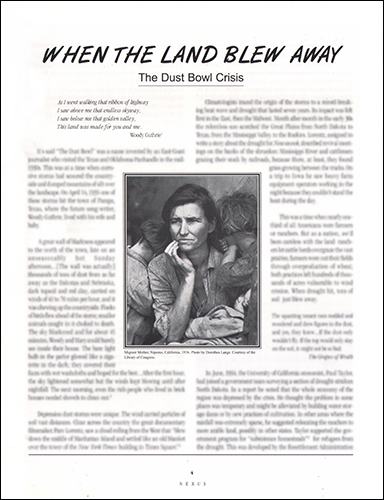
![]() Lesson on the Dust Bowl – When the Land Blew Away – 3 Pages & Activities
Lesson on the Dust Bowl – When the Land Blew Away – 3 Pages & Activities
In the dramatic lesson “When the Land Blew Away – The Dust Bowl Crisis,” we invite students to listen to a selection of Woody Guthrie Dust Bowl songs, watch and respond to the Pare Lorentz documentary The Plow that Broke the Plains, and research “Harvest Gypsies,” the series of articles Steinbeck wrote for The San Francisco News . Then, in an essay or project presentation, we ask students to compare and contrast several perspectives of the crisis.
This chapter aligns with Common Core Standards CCSS.ELA-LITERACY.RL.7, and RL.8 (for 9-10 and 11-12); History standards CCSS.ELA-LITERACY.RH.1, RH.4, RH.6 and RH.9 (for 9-10 and 11-12) as well as Anchor standards CCRA.R.7 and R.9.
The Grapes of Wrath Lessons Part V – 1930s Activist Art and Government Art

![]() Lesson on Thematic Connections between The Grapes of Wrath and Charlie Chaplin’s Modern Times – 3 Pages & Activities
Lesson on Thematic Connections between The Grapes of Wrath and Charlie Chaplin’s Modern Times – 3 Pages & Activities
“A twitch at the controls could swerve the cat; but the driver’s hands could not twitch because the monster that built tractors, the monster that sent the tractor out, had somehow got into the driver’s hands, into his brain and muscle…” – The Grapes of Wrath
What does Chaplin’s hilarious masterpiece Modern Times have in common with the gritty realism of The Grapes of Wrath? In this lesson students compare and contrast Strikes, Red Scare phobias, Machine-age dehumanization, the Great Depression, and the “buck up” attitude that kept millions of resilient Americans from sinking in the Depression’s mire in The Grapes of Wrath and the film Modern Times. This delightful lesson helps students see the bright side of the Great Depression and The Grapes of Wrath – American resilience – and the dark side through an alternative lens – popular period cinema.
Lesson aligned with Common Core Standards CCSS.ELA-LITERACY.RL.2, and RL.8 (for 9-10 and 11-12); and Anchor standards CCRA.R.7 and R.9.
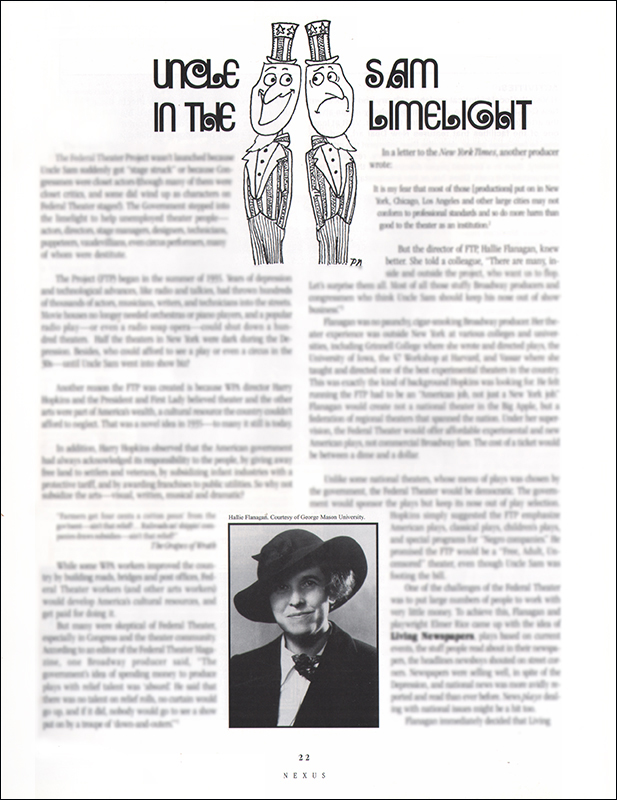
![]() Uncle Sam in the Limelight and Lessons on Living Newspapers – 4 Pages & Activities
Uncle Sam in the Limelight and Lessons on Living Newspapers – 4 Pages & Activities
TEXT SAMPLE:
“Living Newspapers were multimedia productions, with projections on scrims (see-through screens that images can be projected on from behind or in front), open staging, aural and visual images, pantomime, dance, news reels, music and a variety of stage levels. Living Newspapers assaulted all the audience’s senses.”
“The Living Newspaper became the most controversial part of the Federal Theatre Project, and FTP director Hallie Flanagan didn’t start out by soft-peddling it. The first Living Newspaper, Ethiopia, tackled the controversial Ethiopian War. But it never made it to the stage. The State Department demanded the show be canceled before opening night. They feared it might upset Fascist Italy and trigger…” [NEXUS, The Grapes of Wrath and the American Dream, p.23]
This lesson is aligned with Common Core Standards CCSS.ELA-LITERACY.RL.2, and RL.8 (for 9-10 and 11-12); and Anchor standards CCRA.R.7 and R.9.
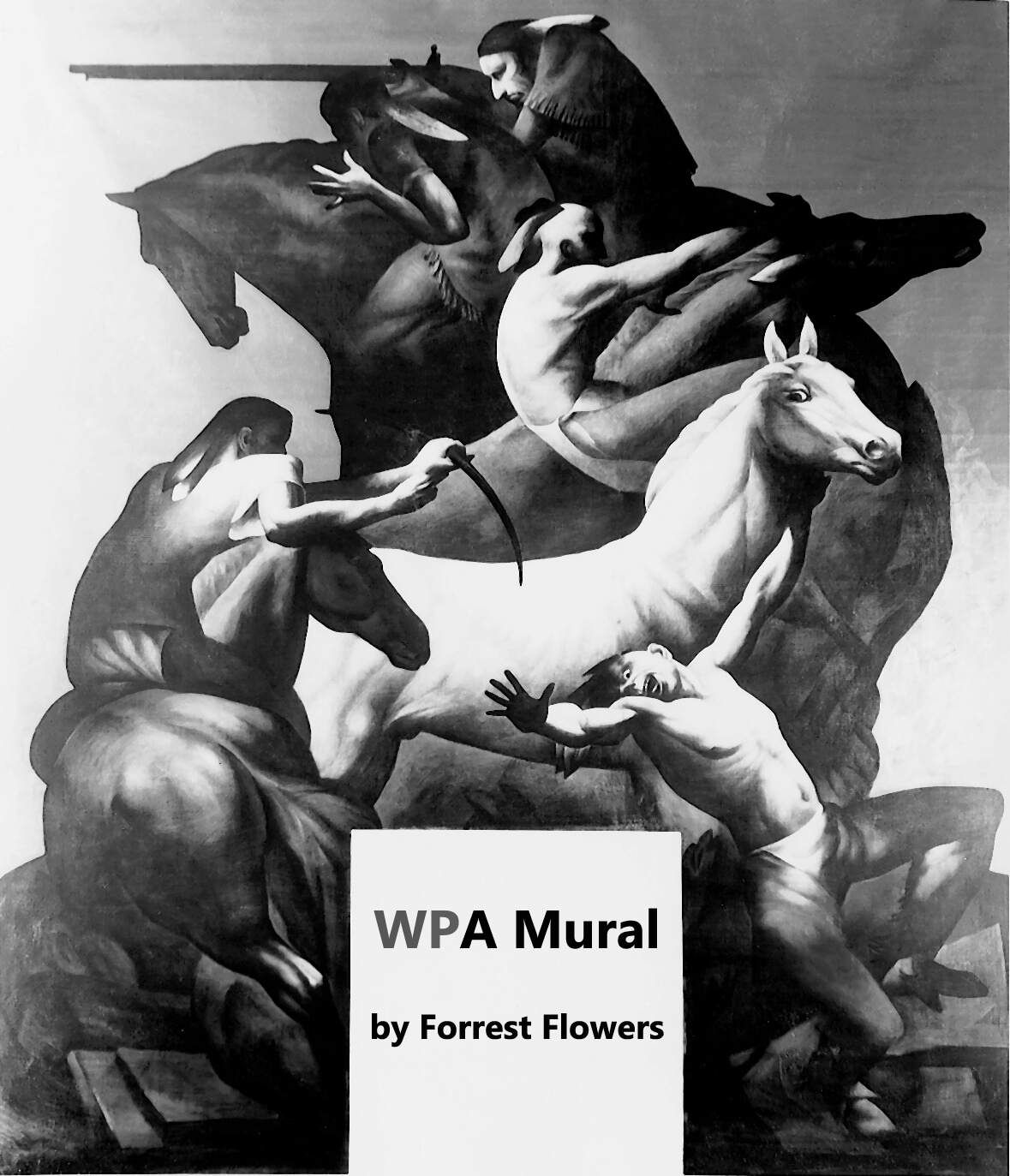
![]() New Deal Art Lesson – Art For the People and By the People – 3 Pages & Activities
New Deal Art Lesson – Art For the People and By the People – 3 Pages & Activities
This interactive lesson teaches students to interpret WPA art that reads like visual poetry or visual narrative. Like The Grapes of Wrath, some of the art reflects themes of injustice, marginalization and stigmatization of outsiders and the poor.
The lesson is aligned with Common Core Standard CCSS.ELA-LITERACY.RL.1 (for 9-10 and 11-12); Anchor standards CCRA.R.7 and R.9, and National Core Art Standards, Program 8, Anchor Standards 7, 8 and 11 (for 9-10 and 11-12).
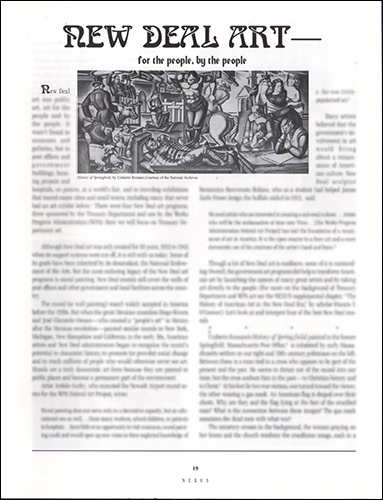

![]() People’s Theater and Steinbeck and the Stage – 2 Pages & Activities
People’s Theater and Steinbeck and the Stage – 2 Pages & Activities
In the “Steinbeck, the Group Theatre and People’s Teachers” lesson students learn that the historic Group Theatre (Harold Clurman, Cheryl Crawford, Lee Strasberg, Elia Kazan, Francis Farmer, John Garfield, Stella Adler, Sidney Lumet, Lee J. Cobb, Karl Malden and others) and many 30’s “people’s theaters” shared Steinbeck’s belief in the “human family” and, like the author of The Grapes of Wrath, wrote, directed and acted under the assumption that art can and should provoke social change.
The Grapes of Wrath Lessons Part VI – New Deal America 
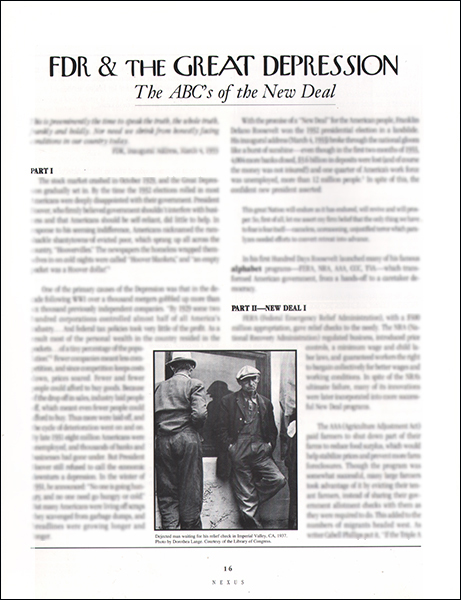
![]() Learning the New Deal Alphabet – 3 Pages & Activities
Learning the New Deal Alphabet – 3 Pages & Activities
Ihe chapter “The ABCs of the New Deal” teaches students the ins and outs of FDR ‘s efforts to lift America out of the Great Depression through his administration’s innovative “alphabet” programs.
The Grapes of Wrath Lessons Part VII – Science and Music Connections
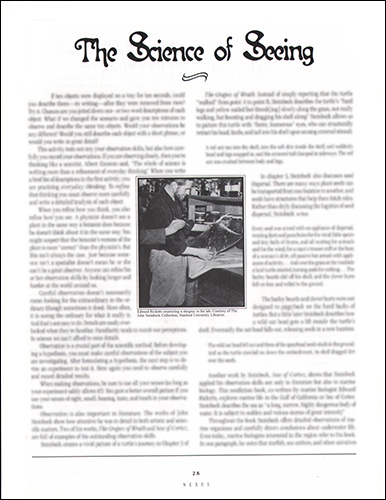
![]() Lessons in Observation – Steinbeck and Marine Biology – 2 Pages & Activities
Lessons in Observation – Steinbeck and Marine Biology – 2 Pages & Activities
THE SCIENCE OF SEEING, the companion lesson to THE ART OF SEEING, teaches students how Steinbeck applied his high-caliber observation skills to marine biology. In Sea of Cortez, the book Steinbeck co-wrote with marine biologist Edward Ricketts (shown at left studying a stingray), students learn that Steinbeck’s sharp observations of natural life in The Grapes of Wrath are analogous to his careful observations of sea life in Sea of Cortez (a book that is often referenced by marine biologists studying the Sea of Cortez today). This chapter, which teaches students that strong observation skills are essential in many disciplines, includes two science experiments – “Observing without Seeing,” and “Is Black Really Black?” – that exercise and hone students’ observation skills.
This lesson meets Common Core Science Standard CCSS.ELA-LITERACY.RST.9-10.3. Follow precisely a complex multi-step procedure when carrying out experiments, taking measurements, or performing technical tasks, attending to special cases or exceptions defined in the text.
TEXT SAMPLE
“Careful observation doesn’t necessarily mean looking for the extraordinary in the ordinary (though sometimes it does). More often it is seeing the ordinary for what it really is. And that’s not easy to do. Details are easily overlooked when they’re familiar. Familiarity tends to numb our perceptions. In science we can’t afford to miss details…” [The Grapes of Wrath and the American Dream, pp. 28-29]
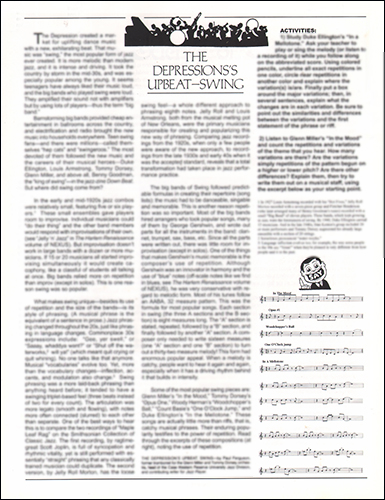
![]() Teaching Period Music with The Grapes of Wrath – 1 Page & Activities
Teaching Period Music with The Grapes of Wrath – 1 Page & Activities
The chapter “The Depression’s Upbeat, Swing,” teaches students to identify theme and variation patterns in the Swing Music of Benny Goodman, Glenn Miller, and others, and to write their own swing compositions using the most popular tune-pattern of the Swing Era.
For more on theme and variation see The Grapes of Wrath Supplement “Repetition in Literature and Music,” which examines Steinbeck’s use of repetition and theme and variation in the global chapters of The Grapes of Wrath (in which Steinbeck adopts a biblical style) and compares it to examples of repetition/theme and variation in Ecclesiastes (King James Bible), Beethoven’s 5th Symphony, and Handel’s “Hallelujah Chorus.” For more on theme and variation in music see “Jelly ‘n Jazz” in The Harlem Renaissance volume of NEXUS and “Sounds and Rounds of the Renaissance” in the Romeo and Juliet and the Renaissance volume.

NEXUS SUPPLEMENTS can be accessed under the SUPPLEMENTS menu. NOTE: NEXUS supplements and books are protected by U.S. Copyright and cannot be photocopied or downloaded.
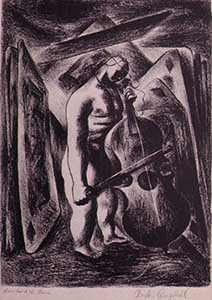
 Teaching Guidelines and Supplements for The Grapes of Wrath
Teaching Guidelines and Supplements for The Grapes of Wrath
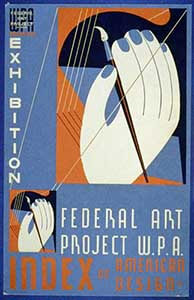
 The Grapes of Wrath Lesson Plans – see Lesson Plans in the NEXUS menu.
The Grapes of Wrath Lesson Plans – see Lesson Plans in the NEXUS menu.
NEXUS is a 501(c)(3) nonprofit based in Cleveland, OH. Our mission is to provide schools with outstanding interdisciplinary resources that inspire students to THINK, LINK and IMAGINE
A portion of our proceeds is donated annually to UNICEF’S Audrey Hepburn All Children in School Fund.


